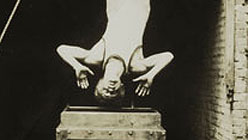When Dorothy peered behind the curtain in The Wizard of Oz and saw the nuts and bolts that created the ‘Great and Powerful Oz,’ all the magic deflated. We understood, like Dorothy, that the wizard was only a man and only capable of so much. Now imagine the scenario running backwards. We will start with a man, Erlich Weiss, and end up with the great Harry Houdini — and even after learning how the rabbit gets placed in the hat, we will still be in awe.
The exhibition at the San Francisco Contemporary Jewish Museum, Houdini: Art and Magic, tells the life story of Harry Houdini through his personal ephemera. The theatrically lit space is filled with wall-sized photographs of Houdini performances, show advertisements, video projections, and stage props. On one level the exhibit is the story of a man’s transformation from immigrant to magician to film star to national icon. This story in itself is compelling on its own; however, another layer is added to the mix.
The curators have selected 26 contemporary art pieces and integrated them into the biographical show. The arts blend perfectly with Houdini’s aged items. Fresh work not only breathes new life into the Houdini exhibit, but it also invites the viewer to question the relationship (as the title explains) between art and magic.

Whitney Bedford, Houdini (Upside Down), 2007, Courtesy of Cherry and Martin, Los Angeles and Susanne Vielmetter Los Angeles Projects.
There are many similarities between art maker and magic maker. Both request the viewer to suspend belief and hand over control to the maker. Both use sleight of hand to create illusions. A life-size photograph by Tim Lee shows the artist bound while reading a book by Robert Smithson. Only upon closer inspection do we realize the photo is taken with the artist suspended upside down. The photograph exists as a magic trick complete with “ta-da!”



